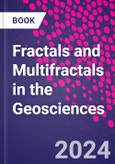Fractals and Multifractals in the Geosciences details the application of a wide range of multifractal methods, including many novel ones developed by the author, along with the assessment of uncertainty in sample classification and stability of spatial patterns. This book also provides criteria for selection of the most effective combination of data pre-processing and multifractal modeling to extract desired features or signals in the data. The book specifically aims to introduce, apply, and test novel multifractal models that account directly for changes in relationships between variables, as well as the effects of distance between samples and the source of anomalous metal contents in geoscience samples. Linked to this will be assessment of the effects of different pre-processing of data prior to application of the models and quantification/model uncertainty in geochemical anomaly maps, associated with sample classification and spatial interpolation. Gaussian simulations such as Sequential Gaussian Simulation and Monte Carlo Simulation will be applied to the new multifractal models developed and a suite of existing models, including (simulated) concentration-area, spectrum-area, singularity and other models.
Fractals and Multifractals in the Geosciences will be invaluable for mathematical geoscientists, geostatisticians, exploration, applied, urban and environmental geochemists, computational geoscientists, data scientists, and GIS professionals who need to better understand fractal geometry, along with its theory and applications in geochemical anomaly classification to generate maps that are helpful for decision-making for follow-up sampling and explorations.
Please Note: This is an On Demand product, delivery may take up to 11 working days after payment has been received.
Table of Contents
1. The theory of fractal geometry
2. Introduction: characterising and mapping anomalies
3. Geochemical datasets
4. Novel multifractal classification models
5. Effectiveness and uncertainty in geochemical anomaly classification models
6. Spatial uncertainty in categorising geological data
7. General discussion and conclusions
Authors
Behnam Sadeghi CSIRO Mineral Resources, Australian Resources Research Centre (ARRC), Kensington, Australia; and Earth and Sustainability Science Research Centre, School of Biological, Earth and Environmental Sciences, University of New South Wales, Australia.Dr. Behnam Sadeghi, a pioneering geoscientist, is a Research Fellow at the ARRC in CSIRO, Australia, and a Fulbright Research Scholar at the Carnegie Institution for Science, EPL, Washington, D.C., United States. His expertise lies in mineral exploration, integrating mathematical geosciences, geostatistics, GIS, and data analytics, providing profound insights into critical minerals. Holding a PhD in Geosciences from the University of New South Wales, Dr. Sadeghi's groundbreaking work includes innovative multifractal classification models and sustainable mineral exploration, recognized by his prestigious IAMG's Founders Scholarship (2020) and Andrei Borisovich Vistelius Research Award (2023). His roles as Associate Editor and Board member for leading journals like Ore Geology Reviews highlight his influence. With global collaborations across academia, industry, and research institutes, he has earned fellowships from respected bodies, including FAAG, FAusIMM, FAIG, and the title of RPGeo by AIG.








